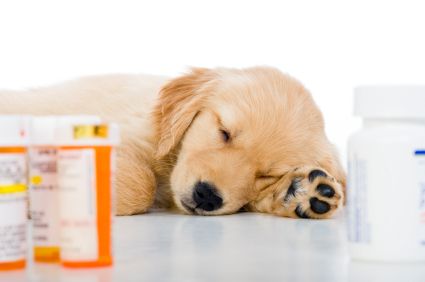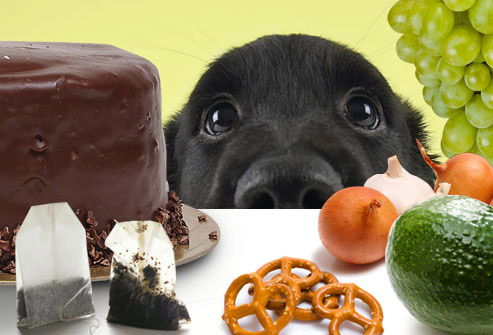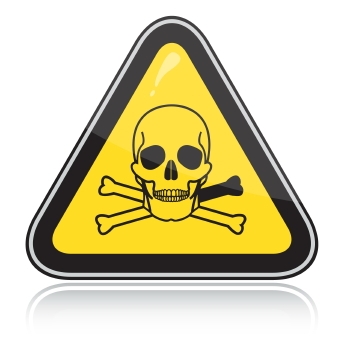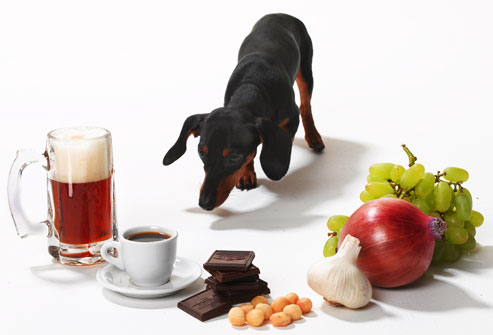If you have ever wondered what the number one cause of poisoning in dogs is, wonder no more.
 Motrin, Advil and other human medications account for the vast majority of companion animal poisoning cases each year. Other substances that are poisonous to dogs are obvious things most people have heard of like antifreeze and chocolate but there are many things that can make your dog sick that just might surprise you. Remember a dog is very much like a toddler and is quite likely to put anything that looks appealing or appetizing into their mouth. Below is a list of items potentially dangerous to the health of your Lovebug that you may not be aware of.
Motrin, Advil and other human medications account for the vast majority of companion animal poisoning cases each year. Other substances that are poisonous to dogs are obvious things most people have heard of like antifreeze and chocolate but there are many things that can make your dog sick that just might surprise you. Remember a dog is very much like a toddler and is quite likely to put anything that looks appealing or appetizing into their mouth. Below is a list of items potentially dangerous to the health of your Lovebug that you may not be aware of.
Chocolate contains theobromine and theophylline, a compound that is a cardiac stimulant and a diuretic. Symptoms include vomiting, tremors and increased heart rate.
Cocoa bean mulch, a common byproduct of chocolate, used in gardens has been found to cause the same symptoms as chocolate when dogs eat it.
 Onions and garlic contain the toxic ingredient thiosulphate. Onions are more of a danger. Dogs affected by onion toxicity will develop hemolytic anemia, where the pet’s red blood cells burst while circulating in its body. Symptoms include Hemolytic Anemia, labored breathing, liver damage, vomiting, diarrhea, and discolored urine, coma and death.
Onions and garlic contain the toxic ingredient thiosulphate. Onions are more of a danger. Dogs affected by onion toxicity will develop hemolytic anemia, where the pet’s red blood cells burst while circulating in its body. Symptoms include Hemolytic Anemia, labored breathing, liver damage, vomiting, diarrhea, and discolored urine, coma and death.
Wild Mushrooms can be extremely toxic to your dog and he may experience symptoms only a few moments after consumption. Symptoms include vomiting, diarrhea, lethargy and abnormal drooling.
As few as a handful of raisins or grapes can make a dog ill. Symptoms include vomiting, diarrhea, abdominal pain, and lethargy. If ingested, it can cause liver damage or kidney failure in dogs.
 Macadamia nuts are another concern, along with most other kinds of nuts. Their high phosphorus content is said to possibly lead to bladder stones. Dogs develop a tremor of the skeletal muscles, and weakness or paralysis of the hindquarters. Affected dogs are often unable to rise and are distressed, usually panting. Some affected dogs have swollen limbs and show pain when the limbs are manipulated.
Macadamia nuts are another concern, along with most other kinds of nuts. Their high phosphorus content is said to possibly lead to bladder stones. Dogs develop a tremor of the skeletal muscles, and weakness or paralysis of the hindquarters. Affected dogs are often unable to rise and are distressed, usually panting. Some affected dogs have swollen limbs and show pain when the limbs are manipulated.
Moldy food or garbage can cause seizures, panting, hyper activity, vomiting, uncoordinated movements, weakness, increased heart rate, increased body temperature, dehydration and lack of appetite.
 Sugarless candies can be toxic to pets. Candies containing xylitol have been recognized by the National Animal Poison Control Center to be a risk to pets. This compound can cause liver damage and death in dogs susceptible to being poisoned with xylitol. If your dog ingests sugarless candy it would be best to contact the NAPCC (1-888-426-4435). It is possible your vet will not be familiar with this source of poisoning as this information is fairly new and candies have not usually been associated with poisonings in dogs if they did not contain chocolate as the major ingredient
Sugarless candies can be toxic to pets. Candies containing xylitol have been recognized by the National Animal Poison Control Center to be a risk to pets. This compound can cause liver damage and death in dogs susceptible to being poisoned with xylitol. If your dog ingests sugarless candy it would be best to contact the NAPCC (1-888-426-4435). It is possible your vet will not be familiar with this source of poisoning as this information is fairly new and candies have not usually been associated with poisonings in dogs if they did not contain chocolate as the major ingredient
Raw salmon and trout can be infected with a parasite called Nanophyetus salmincola, a type of trematode worm. The worms themselves can be infected with a type of bacteria known as Neorickettsia helminthoeca. The bacteria only infects canids; other animals show no symptoms from eating it. When dogs eat raw fish infected with this bacteria, they can show symptoms including weakness, vomiting, loss of appetite, swollen glands, and fever. Ninety percent of untreated dogs die. However, cooking kills the worm and the bacteria.
Poinsettia, Holly & Mistletoe – Despite common misconceptions, poinsettias are only mildly toxic, and most dogs who eat them will experience no symptoms at all. Some dogs will drool or vomit after eating them. Holly causes intense nausea, vomiting and diarrhea. Mistletoe causes vomiting, diarrhea, neurological problems and heart failure.
Most plants in large amounts can be potentially toxic. These common flowers are particularly dangerous: amaryllis, aconite, azalea, belladonna, buckeye, foxgloves, hyacinth, hydrangea, ivy, all species of lily, night shade, rhododendron, tulip, sego palm and yew. Symptoms of ingestion include: dilated eyes, vomiting/diarrhea, irritation around mouth, swelling of the mouth and throat, excessive drooling, excessive thirst, irregular heartbeat/breathing, muscle tremors, seizures, coma, and death.
 Antifreeze contains sweet-tasting ethylene glycol, among other dangerous chemicals, highly fatal to pets even in the smallest amounts. Keep all chemicals out of canine reach. Symptoms of ingestion include vomiting/diarrhea, dilated eyes, depression, increased thirst, kidney failure, seizures, irregular heartbeat/breathing, coma, and death.
Antifreeze contains sweet-tasting ethylene glycol, among other dangerous chemicals, highly fatal to pets even in the smallest amounts. Keep all chemicals out of canine reach. Symptoms of ingestion include vomiting/diarrhea, dilated eyes, depression, increased thirst, kidney failure, seizures, irregular heartbeat/breathing, coma, and death.
Rat Poisons that are meant to attract rodents also attract your dog. Insecticides can also be easily accessed by your dog nosing around in the garden, and his flea/tick collar can make him sick if he chews on it. It is crucial you keep rat bait in inaccessible places to your dog, and monitor him if he wears a flea/tick collar or is in the garden. Pesticide poisoning symptoms include: Fatigue, pale gums, internal bleeding, nosebleeds, blood in urine/stool, excessive drooling, breathing difficulty, muscle tremors, and death.
Mothballs are pesticides that slowly release a gas vapor to kill and repel moths and other insects. The chemicals in mothballs can be inhaled, absorbed through the skin, or absorbed through the stomach and intestines. Naphthalene mothballs, or old-fashioned mothballs, are considered the most toxic type of mothball. Modern PDB mothballs are less toxic but still can cause illness, especially when ingested. Clinical signs of mothball poisoning include vomiting, mothball-scented breath, pale or brown gums, weakness or lethargy, difficulty breathing, tremors, seizures, liver and kidney failure.
WHAT TO DO – If you believe your pet has ingested something toxic, don’t wait! Contact your vet or the National Animal Poison Control Center immediately. It could mean the difference between life and death to your devoted furry family members. You can reach the NAPCC by calling 1-888-426-4435.
